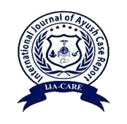Chakshushya Basti and Adjuvant Ayurvedic Remedies in the Management of Keratoconus – A Case Report
Abstract
Keratoconus is a non-inflammatory bilateral ectatic condition of cornea in its axial part presenting with defective vision due to progressive myopia and irregular astigmatism. It is diagnosed by clinical examination and corneal topographic techniques. In contemporary medicine, it is treated with collagen cross linking which may slow down the disease progress, effectiveness of treatment is still questionable. In Ayurveda there are no direct references for keratoconus, based on symptoms it can be correlated to Prathama Patalagata Timira, being Vatika predominance. This study reports a case of 25 years old female who had presented with the complaints of diminution of vision for distant objects associated with eyes irritation, frequent headache and photophobia for 1 years. Considering the symptoms and Dosha Dushya involvement, Vatahara line of treatment like Chakshushya Basti, Snehapana, Pratimarsha Nasya, Netra Pindi and Rasayana Yoga adopted here. Total treatment period was of 45 days with the follow up of 1.5 months. After treatment patient got significant improvement in vision, eye irritation, headache and photophobia with also improvement in Keratometry and pachymetry readings.

This work is licensed under a Creative Commons Attribution-NonCommercial-NoDerivatives 4.0 International License.

